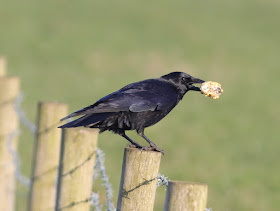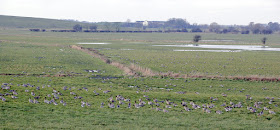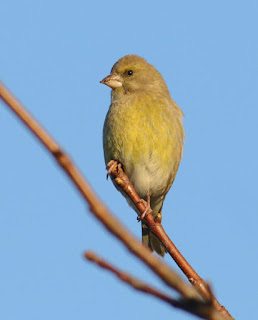New field guides come thick and fast nowadays. No sooner have we invested in and digested a new one than yet another appears to tempt us. And rather like new cars that grow in size from the previous model and prove a tight fit in narrow lanes and car park spaces, so do the dimensions of field guides seem to outgrow their hoped for size. Fitting the latest ones into the average Barbour or multi-pocketed jacket requires a fair amount of ingenuity. Either that or the pristine volume lies forgotten in the glove compartment or sits at home waiting to be consulted upon our return home, thus defeating the object of a guide for use in the great outdoors.
But now along comes a new field guide that promises not only 860 species and 2,200 photographs but undertakes to fit it all into a genuine pocket size of 190mm x 135mm and less than 30mm thick. For those of us brought up with feet and inches that equates to a handy and less than 8in x 6in x 1½in and weighs in to an acceptable 800 grams.
Birds of Europe, North Africa and the Middle East - Princeton Press
The book under the spotlight today is “Birds of Europe, North Africa, and the Middle East” by Frédéric Jiguet and Aurélien Audevard, two distinguished French ornithologists. The latter may be better known by British birders from his occasional articles in Dutch Birding and Birdwatch. The book has been translated into English from the original French Edition aimed at an International audience rather than a British one.
I was grateful for the brief eight pages that comprised the Contents and Introduction. Anyone who buys a serious guide that covers Europe, Africa and The Middle East will surely appreciate minimal information about how to identify birds and the part played by habitat, weather and the various seasons of the year.
The brevity of the early pages allows the remainder of the 435 pages to be devoted entirely to the birds. And those pages are very good with every species mentioned depicted by way of very good quality photographs to help identification and where distinctive features are signposted to the reader.
The brevity of the early pages allows the remainder of the 435 pages to be devoted entirely to the birds. And those pages are very good with every species mentioned depicted by way of very good quality photographs to help identification and where distinctive features are signposted to the reader.
Birds of Europe, North Africa and the Middle East - Princeton Press
Birds of Europe, North Africa and the Middle East - Princeton Press
The book is bang up to date with the inclusion of species such as Scopoli’s Shearwater, Cabot’s Tern and a good range of single-record phylloscopus warblers that have appeared in Europe in recent years. It is very comprehensive in its coverage of the huge range of gulls which appear rarely in European waters from as far afield as the Azores and Arctic Northern Finland e.g. Baltic Gull and Azores Yellow-legged Gull.
One of the things I did like is the inclusion of escaped or introduced species such as the Parrotbills in Italy, the Leiothrix in France & Spain, Weavers, Bishops, Mynas and Munias from Iberia, or the Iago Sparrow found in Holland. From experience we know how such species often find a niche, multiply and soon go on to become naturalised to their adopted country. There are also birds I’d not seen in other guides e.g. "Thick Billed" Reed Bunting", Grey-necked Bunting and “Ambiguous" Reed Warbler”.
Birds of Europe, North Africa and the Middle East - Princeton Press
Birds of Europe, North Africa and the Middle East - Princeton Press
In fact the whole book really emphasises how we in Britain and the near Continent are in the centre of a huge Birding Universe where birds from North, South, East and West can and do occur, including as the book does, many pages devoted to North American birds.
Students of taxonomy and sub-species may find the book’s treatment of their subject inconsistent by way of inclusion of for instance, the slightly different races of Mediterranean Spotted Flycatcher while omitting the sometimes noticeably different seven sub-species of the Common Linnet found across Europe.
I found the explanation and pictures of the two races of Greater White-fronted Goose, flavirostris and albifrons to be less than ideal while just two photographs of Common Redpoll fail to describe adequately the Lesser Redpoll as both widespread and commonplace in Britain and parts of Europe. But then as mentioned earlier, this is a book aimed at a cosmopolitan audience rather than a wholly English speaking one, and neither do the authors claim the book to be a treatise on taxonomy.
The textual descriptions are of necessity succinct, simply to allow the number and variety of species covered to fit into the easily portable book described above. Likewise the number of maps and photographs allowed for each species’ ages, plumages and postures is somewhat compromised by the available space, but not enough to deter a serious birder looking to buy.
Birds of Europe, North Africa and the Middle East - Princeton Press
Birds of Europe, North Africa and the Middle East - Princeton Press
Overall I really liked the quality, look and feel of this book. The size, layout and composition makes for a truly usable field guide rather than a coffee table book. By integrating the three huge areas of Europe, North Africa and the Middle East it covers a range of species not previously seen in an everyday field guide.
The Birds of Europe, North Africa, and The Middle East is available now from the publisher Princeton University Press or the usual Internet outlets. The price is less than £20.00 or $30. I reckon that's a good buy.
Linking today to Eileen's Saturday.
























































